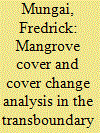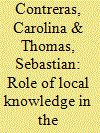|
|
|
Sort Order |
|
|
|
Items / Page
|
|
|
|
|
|
|
| Srl | Item |
| 1 |
ID:
167536


|
|
|
|
|
| Summary/Abstract |
Blue carbon ecosystems are diverse and highly productive coastal habitats (mangroves, seagrasses, and tidal marshes) that sequester large quantities of carbon and provide a suite of important ecosystem services (‘co-benefits’) for humans and the environment. These ecosystems are being threatened globally due to land-use change driven by expanding agriculture, aquaculture, coastal development, and pollution. Climatic impacts further threaten the resilience, functionality, and adaptability of blue carbon ecosystems. ‘Marine protected areas’ (MPAs) provide a statutory approach for protecting coastal and marine ecosystems, yet are unlikely to meet ‘additionality’ requirements. Whereas other effective conservation measures (OECMs) including community-based ‘locally managed marine areas’ (LMMAs) provide opportunities to enhance blue carbon conservation and restoration efforts. LMMAs likely deliver additional sequestration, although ensuring ‘permanence’ of carbon stocks may be more difficult to achieve. This review summarizes key approaches of blue carbon monitoring; governance systems; policy instruments; and investment pathways for conservation and restoration.
|
|
|
|
|
|
|
|
|
|
|
|
|
|
|
|
| 2 |
ID:
167532


|
|
|
|
|
| Summary/Abstract |
The Indian Ocean is home to some of the most extensive coastal blue carbon ecosystems on the planet. Together, the nations within and surrounding this ocean basin contain approximately 50% (an estimated 76,275 km2) of the world’s mangrove forests and a large, but unknown, proportion of its seagrass meadows. The nations of the Indian Ocean have an opportunity to be world leaders in restoration and protection of these ecosystems, which can help mitigate climate change, enhance livelihoods and protect shorelines from erosion and storm damage. Already, Indian Ocean nations are showing leadership by acknowledging blue carbon ecosystems in their Nationally Determined Contributions, and by championing efforts to establish some of the largest blue carbon restoration projects globally. However, more can be done. We outline a research agenda that will pave the way for effective evidence-based policy in the Indian Ocean, by reducing uncertainty and providing the tools and knowledge needed.
|
|
|
|
|
|
|
|
|
|
|
|
|
|
|
|
| 3 |
ID:
167535


|
|
|
|
|
| Summary/Abstract |
There has been a growing interest in restoring mangroves to reduce and offset carbon (C) emissions, but it is still unknown whether restored mangroves provide ‘blue carbon’ services similar to natural ones. This study aimed to determine if 10 year-old restored mangroves in abandoned aquaculture ponds in Perancak Estuary, Bali have similar net primary productivity (NPP) and C sequestration to those of intact mangroves. Tidal re-instatement in the ponds has occurred and facilitated mangrove regeneration and sediment accumulation. We found that NPP were similar between natural and restored mangroves. Soil C sequestration in restored mangroves was similar to the natural mangroves, but the soil respiration (CO2 efflux) was lower. The source of C in mangrove sediments was mainly of mangrove origin, confirming the role of NPP in sediment C sequestration. We suggest that many components of the carbon cycle of the mangroves have been restored within 10 years since the reestablishment of the mangrove.
|
|
|
|
|
|
|
|
|
|
|
|
|
|
|
|
| 4 |
ID:
167534


|
|
|
|
|
| Summary/Abstract |
Mangrove forests are among the most threatened ecosystems on earth. Some of these forests traverse national boundaries complicating their management due to differences in governance structures between countries. To improve the management of transboundary species regular monitoring is essential. Remotely sensed data were used to estimate forest cover and analyze conditions of mangroves in the proposed transboundary conservation area (TBCA) between Kenya and Tanzania. Image analysis was performed using unsupervised and supervised classification methods. The transboundary mangroves cover an estimated 11,906 ha; 55% being in Kenya, 45% in Tanzania. Ceriops tagal, Avicennia marina, and Rhizophora mucronata species co-dominate the mangroves of the transboundary area. The hotspot for loss and degradation of mangrove in the TBCA is Vanga in Kenya with a loss of 27 ha/yr. Harvesting of mangrove wood products have contributed to the loss of mangroves in the transboundary area. TBCA formation could play a critical role in ensuring sustainable mangrove resources utilization.
|
|
|
|
|
|
|
|
|
|
|
|
|
|
|
|
| 5 |
ID:
167531


|
|
|
| 6 |
ID:
167537


|
|
|
|
|
| Summary/Abstract |
There are more than 1500 partnerships and initiatives currently addressing Sustainable Development Goal #14 (Life Below Water), with blue carbon activities – carbon-oriented conservation and restoration projects in coastal ecosystems – representing a small proportion. A key challenge for blue carbon initiatives is the integration of social and cultural dimensions within governance mechanisms – a common problem in global environmental governance. An important question is how these mechanisms integrate local knowledge, traditional customs, and rights, especially in the climate-vulnerable contexts of island states in the Indo-Pacific region. This study describes global blue carbon governance – considering market-based instruments, public investment, partnership initiatives, and community-centred management schemes – and evaluates the extent to which these different approaches facilitate or constrain the integration and agency of local knowledge. This research offers valuable insights on the applicability of blue carbon governance mechanisms in small island states (SIS) in the Indo-Pacific region, and their potential to contribute to sustainability outcomes including social-ecological health and environmental justice.
|
|
|
|
|
|
|
|
|
|
|
|
|
|
|
|
| 7 |
ID:
167533


|
|
|
|
|
| Summary/Abstract |
Fisheries are important sources of livelihoods to coastal communities. In the tropics fishing is conducted from mangroves, seagrass meadows to coral reefs. Studies on fisheries in the tropics have focused on coral reef fisheries, with little attention to seagrass meadows and mangroves. Using creel survey and in-depth interviews, this study assessed species composition, abundance and exploitation methods of fisheries from the seagrass meadows of Gazi Bay, Kenya. Eighty-five species were recorded with 8 species accounting for 75.7% of the total catch dominated by Leptoscarus vaigiensis, accounting for 30.9% of the total catch. Five dominant gears were observed: basket traps, hook and stick, handlines, nets and spear-guns. Basket traps were the most dominant accounting for 75.1% of the total catch by volume. These results underscore the value of the seagrass meadows to supporting fisheries. Gear management measures should be implemented for sustainability of the seagrass habitat and associated fisheries.
|
|
|
|
|
|
|
|
|
|
|
|
|
|
|
|
|
|
|
|
|